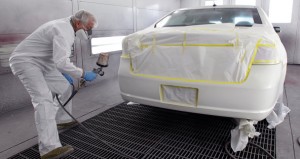The Evolution of Auto-Painting

If you’ve ever bought a new or used car, chances are that it came with a shiny coat of paint. Paint finish is a deal breaker with many cars since scratches and rust spots appear to be more of an indicator of maintenance than the engine, despite how well the latter may run. A vehicle’s paint job is what attracts many individuals into making their car purchase, with generally less thought given to the more technical aspects of vehicle maintenance. However, as a student studying automotive trades training you’re most likely more aware than the average person of what to look for in a well-maintained vehicle.
Revolutionizing Automotive Paint
The nature of the paint job has evolved fairly quickly over a short period of time within the automotive industry. During the industry’s early years, it took a period of roughly 40 days to complete a paint job. During that era, painting was done by hand with a paint brush and varnish. By comparison, working in the automotive trades today must feel absolutely cutting edge! When Henry Ford revolutionized the future of automotive transport, he also did the same with the paint process when he introduced paint to the assembly line that had a quicker drying time, as well as making use of spray guns to apply the paint.

Advancements to Auto-Painting
As auto manufacturing evolved, so did the techniques and paint materials used on cars, and today there are primarily four different types of paint available; lacquer, enamel, urethane and water-based. The appeal of lacquer paint, made popular during the 1920s to 1960s, is that it is cost effective and can be easily applied. However since it chips easily it isn’t as popular as enamel. Enamel paint, which is more durable than lacquer paint, cannot be applied as easily as lacquer paint, as it requires a topcoat. Urethane paint has the durability of enamel paint and the cost of lacquer paint, however requires three-stage application and is highly toxic. The latest best practice in automotive paint technology is using water-based paint. The benefit of water-based paint is that it is non-toxic, therefore can be used at home by anyone who would like to paint their own vehicle. Water-based was created with environment concerns in mind, when government regulations forced paint manufacturers to create paint with low volatile organic compounds (VOC). If you are studying the trades in BC, then you will most likely work with water-based paint.
Today, there is much more variety in the paint options available, such as special flakes in colours and poly-chromatic or faceted finishes, giving car owners many more colour options that the standard black that was the only colour initially available. Some carmakers today mix water borne colours with the plastic that makes the final body or frame part, making them very durable. With the evolution of technology within the automotive industry, there will always be innovations made to prolong the life of a paint job.

